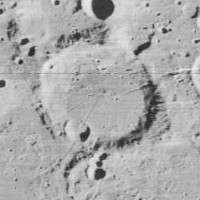Galvani (crater)
Galvani is a lunar impact crater that lies close to the northwestern limb of the Moon, due south of the larger walled plain Volta. It partly overlies the southeast rim of the crater Langley, which occupies half the gap between Volta and Galvani. To the northeast is the large walled plain Repsold, and to the west-southwest, on the far side of the Moon, is the crater McLaughlin.
 Oblique Lunar Orbiter 4 image | |
| Coordinates | 49.6°N 84.6°W |
|---|---|
| Diameter | 80 km |
| Depth | Unknown |
| Colongitude | 86° at sunrise |
| Eponym | Luigi Galvani |
Due to its location, Galvani is viewed from an oblique angle from the Earth, and it appears highly foreshortened. The visibility of this crater is affected by libration of the Moon, so that at times this crater can be hidden from sight.
The rim of Galvani is worn and rounded, with a crater lying along the inner wall to the southwest. The southwestern rim has been modified, and appears straighter than the otherwise circular shape of the perimeter. The inner wall is wider along the western side compared to the east, and thus the midpoint of the level interior floor is offset slightly to the east. A rille from the Rimae Repsold system crosses the northeastern rim and traverses the interior, forking near the midpoint to continue towards the west-southwest and the south.
Satellite craters
By convention these features are identified on lunar maps by placing the letter on the side of the crater midpoint that is closest to Galvani.
| Galvani | Latitude | Longitude | Diameter |
|---|---|---|---|
| B | 49.5° N | 89.0° W | 15 km |
| D | 47.8° N | 88.3° W | 13 km |
References
- Andersson, L. E.; Whitaker, E. A. (1982). NASA Catalogue of Lunar Nomenclature. NASA RP-1097.CS1 maint: ref=harv (link)
- Blue, Jennifer (July 25, 2007). "Gazetteer of Planetary Nomenclature". USGS. Retrieved 2007-08-05.CS1 maint: ref=harv (link)
- Bussey, B.; Spudis, P. (2004). The Clementine Atlas of the Moon. New York: Cambridge University Press. ISBN 978-0-521-81528-4.CS1 maint: ref=harv (link)
- Cocks, Elijah E.; Cocks, Josiah C. (1995). Who's Who on the Moon: A Biographical Dictionary of Lunar Nomenclature. Tudor Publishers. ISBN 978-0-936389-27-1.CS1 maint: ref=harv (link)
- McDowell, Jonathan (July 15, 2007). "Lunar Nomenclature". Jonathan's Space Report. Retrieved 2007-10-24.CS1 maint: ref=harv (link)
- Menzel, D. H.; Minnaert, M.; Levin, B.; Dollfus, A.; Bell, B. (1971). "Report on Lunar Nomenclature by the Working Group of Commission 17 of the IAU". Space Science Reviews. 12 (2): 136–186. Bibcode:1971SSRv...12..136M. doi:10.1007/BF00171763.CS1 maint: ref=harv (link)
- Moore, Patrick (2001). On the Moon. Sterling Publishing Co. ISBN 978-0-304-35469-6.CS1 maint: ref=harv (link)
- Price, Fred W. (1988). The Moon Observer's Handbook. Cambridge University Press. ISBN 978-0-521-33500-3.CS1 maint: ref=harv (link)
- Rükl, Antonín (1990). Atlas of the Moon. Kalmbach Books. ISBN 978-0-913135-17-4.CS1 maint: ref=harv (link)
- Webb, Rev. T. W. (1962). Celestial Objects for Common Telescopes (6th revised ed.). Dover. ISBN 978-0-486-20917-3.CS1 maint: ref=harv (link)
- Whitaker, Ewen A. (1999). Mapping and Naming the Moon. Cambridge University Press. ISBN 978-0-521-62248-6.CS1 maint: ref=harv (link)
- Wlasuk, Peter T. (2000). Observing the Moon. Springer. ISBN 978-1-85233-193-1.CS1 maint: ref=harv (link)